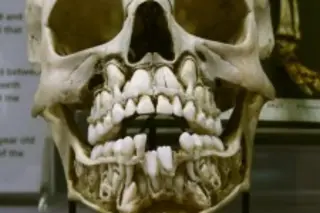Child's skull with baby teeth and adult teeth, Hunterian Museum, London. Photo: Stefan SchäferMaybe it's because of the various traumatic ways I lost my baby teeth, but whatever the reason, teeth feature prominently in my nightmares. And now I have yet another vision to add to the bag of horror: "intranasal teeth" (literally, teeth inside the nose). Apparently (and horrifyingly), it's not unheard of to have teeth stuck inside one's nose. There are a number of ways this can come about, but typically it happens to children. And no wonder--the image to the left shows what the front of a child's face looks like when the adult teeth are about to grow in; from nose to chin, it's pretty much ALL teeth. Not surprisingly, some of these teeth can get a bit lost and grow into the nasal cavity. Other children fall, lose a tooth, and get it stuck in ...
A new thing to fear: "intranasal teeth".
Discover the unusual case of intranasal teeth in children, causes, and treatment options including extraction of intranasal tooth.
More on Discover
Stay Curious
SubscribeTo The Magazine
Save up to 40% off the cover price when you subscribe to Discover magazine.
Subscribe













